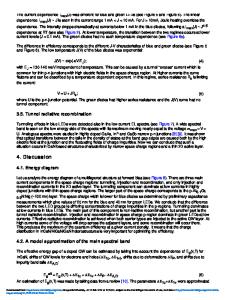Blue Luminescence in Undoped and Zn-doped GaN
- PDF / 163,449 Bytes
- 6 Pages / 612 x 792 pts (letter) Page_size
- 69 Downloads / 418 Views
L11.1.1
Blue Luminescence in Undoped and Zn-doped GaN M. A. Reshchikov and H. Morkoç Virginia Commonwealth University, Richmond, VA 23284, U.S.A. R. J. Molnar MIT Lincoln Laboratory, Lexington, MA 02420, U.S.A. D. Tsvetkov and V. Dmitriev TDI, Inc., Silver Spring, MD 20904, U.S.A. ABSTRACT A broad band with a maximum at about 2.9 eV (blue band) is widely observed in the photoluminescence (PL) and cathodoluminescence (CL) spectra of unintentionally doped GaN grown by metalorganic chemical vapor deposition (MOCVD) or by hydride vapor phase epitaxy (HVPE). In some samples this band exhibits fine structure attributed to electron-phonon coupling, in others it appears featureless. Different defect origin and recombination mechanisms responsible for the blue band have been suggested in the past. The situation is complicated by the fact that bands similar in shape and position were observed also in Zn- and Mg-doped GaN, as well as in undoped GaN after dry or wet etching. We investigated PL in HVPE-grown undoped, Si- and Zn-doped GaN layers in wide temperature and excitation intensity ranges. We have found that the shape, temperature and excitation intensity dependencies of the blue band in undoped GaN are almost identical to those in GaN lightly doped with Zn. Moreover, in both undoped and Zn-doped samples we observed a distinctive set of peaks related to an exciton bound to the Zn acceptor. Although the exact structure of the Zn acceptor is still unknown, our experimental results unambiguously demonstrate that Zn impurity is responsible for the blue band in unintentionally doped GaN. The results of transient PL study are also consistent with the above attribution. INTRODUCTION A blue luminescence (BL) band peaking at 2.9 eV is often observed in PL and CL spectrum of undoped and Si-doped GaN [1-10]. Kaufman et al. [7] attributed the BL band in undoped GaN to deep donor-acceptor pair (DAP) transitions involving residual Mg impurity as acceptor and the VNMg complex as a deep donor. More recently, detailed studies of the BL band in undoped GaN at different temperatures and excitation intensities revealed that it is related to transitions from a shallow donor (or from the conduction band at elevated temperatures) to a deep acceptor [10,11]. Thermal activation energy of the acceptor was estimated as 0.34 eV [11]. Various proposals have been made as to the nature of the defect responsible for the 2.9 eV band in undoped GaN. Besides the above-mentioned assignment of this band to residual Mg, it was also attributed to a gallium vacancy (VGa)-related complex [9,11,12], in particular to VGaON [9] and VGaHn [12]. Note that in a few studies a similar band centered at about 3.0 eV has been observed that exhibited a strong fatigue effect [13-15]. We also observed a broad blue band with a similar fatigue effect in a GaN epilayer grown by molecular beam epitaxy (MBE). With etching experiments using hot phosphoric acid, we attributed this feature to manifestation of the surface states [16]. To elucidate the origin of the 2.9 eV band in und
Data Loading...










